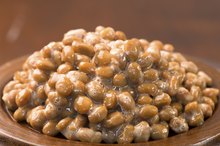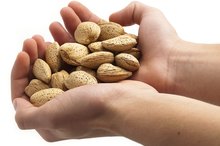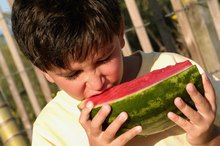What does fact checked mean?
At Healthfully, we strive to deliver objective content that is accurate and up-to-date. Our team periodically reviews articles in order to ensure content quality. The sources cited below consist of evidence from peer-reviewed journals, prominent medical organizations, academic associations, and government data.
- Pharmacognosy Review: Free Radicals, Antioxidants and Functional Foods: Impact on Human Health
- Pharmacognosy Review: Free Radicals, Antioxidants and Functional Foods: Impact on Human Health
- Linus Pauling Institute: Vitamin C
- Linus Pauling Institute: Vitamin E
- Linus Pauling Institute: What’s Good About Fat?
- Journal of Agricultural and Food Chemistry: Fruit Quality, Antioxidant Capacity, and Flavonoid Content of Organically and Conventionally Grown Blueberries
- Journal of Agricultural and Food Chemistry: Fruit Quality, Antioxidant Capacity, and Flavonoid Content of Organically and Conventionally Grown Blueberries
- Linus Pauling Institute: Flavonoids
The information contained on this site is for informational purposes only, and should not be used as a substitute for the advice of a professional health care provider. Please check with the appropriate physician regarding health questions and concerns. Although we strive to deliver accurate and up-to-date information, no guarantee to that effect is made.
Antioxidants in Blueberries vs. Raisins
Raisins have an advantage over blueberries if you’re looking for nutrients such as vitamin B-6 and iron, but when you want to boost antioxidants, you should choose blueberries over raisins. Raisins contain a small amount of two dietary antioxidants -- vitamins C and E -- but blueberries rule the day with five times more of both vitamins. You’ll also get a significant amount of antioxidant flavonoids from blueberries.
Antioxidants Explained
All of the life-sustaining work inside your body, from producing energy to synthesizing tissues and hormones, is accomplished by molecules interacting with other molecules. These reactions result in unhealthy byproducts, including molecules called free radicals. Free radicals are also produced when your body reacts to stressors, such as sunlight and air pollution, according to a report in the July 2010 issue of "Pharmacognosy Review." As free radicals interact with cells, they cause damage called oxidative stress. This is why substances that neutralize free radicals before they harm cells are called antioxidants. Without antioxidants, damage from free radicals accumulates and may cause diseases such as cancer and atherosclerosis.
- All of the life-sustaining work inside your body, from producing energy to synthesizing tissues and hormones, is accomplished by molecules interacting with other molecules.
Vitamin C Stops Free Radicals
What Vitamins Do Peaches Have?
Learn More
The U.S. Department of Agriculture describes vitamin C as having high power to neutralize a wide variety of free radicals. In addition to protecting all types of cells, the water-soluble vitamin also keeps free radicals from damaging proteins, fats, carbs and DNA, according to the Linus Pauling Institute 234. One cup of raw blueberries contains 14 milligrams of vitamin C, compared to 3 milligrams in the same portion of raisins. Women should consume 75 milligrams of vitamin C daily, while men need 90 milligrams.
- The U.S. Department of Agriculture describes vitamin C as having high power to neutralize a wide variety of free radicals.
- One cup of raw blueberries contains 14 milligrams of vitamin C, compared to 3 milligrams in the same portion of raisins.
Vitamin E Protects Fats
Vitamin E has one main job: to provide antioxidant protection to essential fats throughout your body. In this role, it stops free radicals before they destroy fats that fill vital jobs, such as forming cellular structure, regulating genes and producing energy. Vitamin E also protects fats in lipoproteins, which carry cholesterol through your blood. Damage to lipoproteins may increase your risk of cardiovascular disease, according to the Linus Pauling Institute 234. You’ll get 0.8 milligrams of vitamin E from 1 cup of blueberries and barely 0.2 milligrams from raisins. Your recommended dietary allowance for vitamin E is 15 milligrams daily.
- Vitamin E has one main job: to provide antioxidant protection to essential fats throughout your body.
- Damage to lipoproteins may increase your risk of cardiovascular disease, according to the Linus Pauling Institute 2.
Antioxidant Flavonoids
Side Effects of Vitamin K-2
Learn More
Flavonoids represent a very large group of substances produced by plants. They don’t provide nutritional benefits, but they do protect your health by regulating cellular communication and working as antioxidants. Blueberries are a rich source of flavonoids, containing more than 500 milligrams of flavonoids in a 1-cup serving, according to the USDA National Nutrient Database 67. By comparison, raisins only have about 1 milligram. If you have a choice, organically grown blueberries may provide more flavonoids than conventionally grown fruits, according to the USDA’s research published in the July 2008 issue of the “Journal of Agricultural and Food Chemistry. 5”
Related Articles
References
- Pharmacognosy Review: Free Radicals, Antioxidants and Functional Foods: Impact on Human Health
- Linus Pauling Institute: Vitamin C
- Linus Pauling Institute: Vitamin E
- Linus Pauling Institute: What’s Good About Fat?
- Journal of Agricultural and Food Chemistry: Fruit Quality, Antioxidant Capacity, and Flavonoid Content of Organically and Conventionally Grown Blueberries
- USDA Nutrient Database: Blueberries, Raw
- USDA Nutrient Database: Raisins, Seedless
- Linus Pauling Institute: Flavonoids
- Blueberries, raw. FoodData Central. U.S Department of Agriculture. Published April 1, 2019.
- Institute of Medicine (US) Panel on Micronutrients. Dietary Reference Intakes for Vitamin A, Vitamin K, Arsenic, Boron, Chromium, Copper, Iodine, Iron, Manganese, Molybdenum, Nickel, Silicon, Vanadium, and Zinc. Washington (DC): National Academies Press (US); 2001. 10, Manganese.
- Krikorian R, Shidler MD, Nash TA, et al. Blueberry supplementation improves memory in older adults. J Agric Food Chem. 2010;58(7):3996-4000. doi:10.1021/jf9029332
- Devore EE, Kang JH, Breteler MM, Grodstein F. Dietary intakes of berries and flavonoids in relation to cognitive decline. Ann Neurol. 2012;72(1):135-43. doi:10.1002/ana.23594
- Cassidy A, Mukamal KJ, Liu L, et al. High anthocyanin intake is associated with a reduced risk of myocardial infarction in young and middle-aged women. Circulation. 2013;127(2):188-96. doi:10.1161/CIRCULATIONAHA.112.122408
- Kimble R, Keane KM, Lodge JK, Howatson G. Dietary intake of anthocyanins and risk of cardiovascular disease: A systematic review and meta-analysis of prospective cohort studies. Crit Rev Food Sci Nutr. 2019;59(18):3032-3043. doi:10.1080/10408398.2018.1509835
- Yousuf B, Gul K, Wani AA, Singh P. Health benefits of anthocyanins and their encapsulation for potential use in food systems: a review. Crit Rev Food Sci Nutr. 2016;56(13):2223-30. doi:10.1080/10408398.2013.805316
- Martineau LC, Couture A, Spoor D, et al. Anti-diabetic properties of the Canadian lowbush blueberry Vaccinium angustifolium Ait. Phytomedicine. 2006;13(9-10):612-23. doi:10.1016/j.phymed.2006.08.005
- Stull AJ, Cash KC, Johnson WD, Champagne CM, Cefalu WT. Bioactives in blueberries improve insulin sensitivity in obese, insulin-resistant men and women. J Nutr. 2010;140(10):1764-8. doi:10.3945/jn.110.125336
- Cunningham E. Are there foods that should be avoided if a patient is sensitive to salicylates?. J Am Diet Assoc. 2010;110(6):976. doi:10.1016/j.jada.2010.04.020
- Rane A, Lindh JD. Pharmacogenetics of anticoagulants. Hum Genomics Proteomics. 2010;2010:754919. doi:10.4061/2010/754919
- Bouzari A, Holstege D, Barrett DM. Mineral, fiber, and total phenolic retention in eight fruits and vegetables: a comparison of refrigerated and frozen storage. J Agric Food Chem. 2015;63(3):951-6. doi:10.1021/jf504890k
Writer Bio
Sandi Busch received a Bachelor of Arts in psychology, then pursued training in nursing and nutrition. She taught families to plan and prepare special diets, worked as a therapeutic support specialist, and now writes about her favorite topics – nutrition, food, families and parenting – for hospitals and trade magazines.









